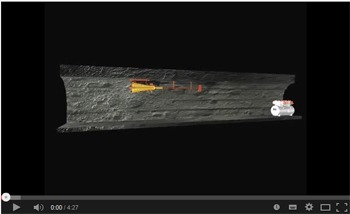During the 9th Session of the Group of Experts on Coal Mine Methane held on 23 October 2014, Mr. Sergey Shumkov who is the representative the Ministry of Energy of the Russian Federation suggested that the extrabudgetary project titled "Application of Best Practices in Specific Coal Mines could be carried out mostly towards the accomplishment of the activity C of the Group of Experts on Coal Mine Methane Work Plan 2014-2015: "Prepare proposals for case studies on the application of best practice guidance in specific coal mines in different regions of the world".
The main deliverable of the project will be a detailed case study, or in-depth analysis, on application of best practices at a reference coal mine, which would demonstrate how the principles outlined in the Best Practice Guidance for Effective Methane Drainage and Recovery in Coal Mines are implemented at operating coal mines around the world.
Mr. Sergey Shumkov proposed to focus on methane explosions reduction and methane safety issues that are poorly detailed in the principles of standard regulation in the Best Practice Guidance for Effective Methane Drainage and Recovery in Coal Mines. The declarative principles of methane safety management are simply drawn in the report and have yet to be expanded upon.
Mining operations run the risk of explosions caused by the accidental ignition of methane gas. The types of explosions can range from small fires or flashes to detonations that are the most powerful explosions. Generally there are three types of protective measures used against the methane explosions.
The first system of protection is stone dust barriers, so-called inert dust. These barriers block the weaker and balancing explosions with speeds from 80 to 230 m/s. The second type of protection is water barriers blocking the fire from explosions with speeds from 100 to 285 m/s. And the third solution using an automated system of explosion suppression by the extinguishing powder blocks larger and faster explosions that have speeds from 40 to 660 m/s.
The proposal of the Russian Federation is to carry out comparative tests of the third type of protection against methane explosions in coal mines within the Group of Experts on Coal Mine Methane as the stone dust and water barriers are not sufficient today. The goal is to make recommendations, which will be reflected in the Best Practice Guidance for Effective Methane Drainage and Recovery in Coal Mines.
The video (Watch video on UNECE’s YouTube channel) demonstrates the basic functionality of an automatic system of explosion suppression called ASES-LE.
The main deliverable of the project will be a detailed case study, or in-depth analysis, on application of best practices at a reference coal mine, which would demonstrate how the principles outlined in the Best Practice Guidance for Effective Methane Drainage and Recovery in Coal Mines are implemented at operating coal mines around the world.
Mr. Sergey Shumkov proposed to focus on methane explosions reduction and methane safety issues that are poorly detailed in the principles of standard regulation in the Best Practice Guidance for Effective Methane Drainage and Recovery in Coal Mines. The declarative principles of methane safety management are simply drawn in the report and have yet to be expanded upon.
Mining operations run the risk of explosions caused by the accidental ignition of methane gas. The types of explosions can range from small fires or flashes to detonations that are the most powerful explosions. Generally there are three types of protective measures used against the methane explosions.
The first system of protection is stone dust barriers, so-called inert dust. These barriers block the weaker and balancing explosions with speeds from 80 to 230 m/s. The second type of protection is water barriers blocking the fire from explosions with speeds from 100 to 285 m/s. And the third solution using an automated system of explosion suppression by the extinguishing powder blocks larger and faster explosions that have speeds from 40 to 660 m/s.
The proposal of the Russian Federation is to carry out comparative tests of the third type of protection against methane explosions in coal mines within the Group of Experts on Coal Mine Methane as the stone dust and water barriers are not sufficient today. The goal is to make recommendations, which will be reflected in the Best Practice Guidance for Effective Methane Drainage and Recovery in Coal Mines.
The video (Watch video on UNECE’s YouTube channel) demonstrates the basic functionality of an automatic system of explosion suppression called ASES-LE.


